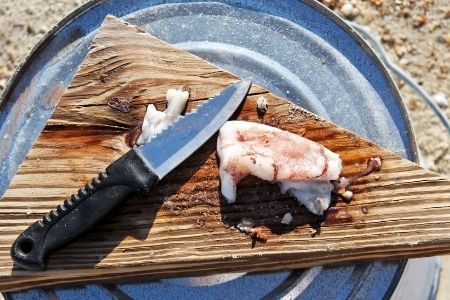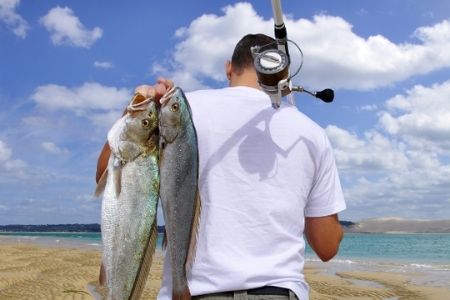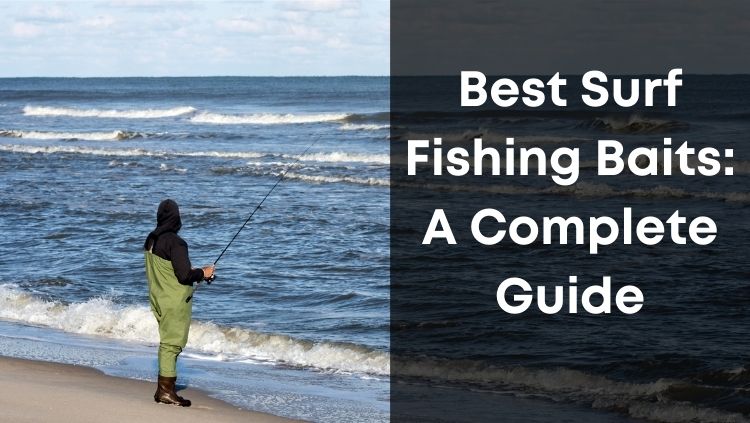Surf fishing is one of the most accessible forms of fishing. All you need is your rod, reel, bait, and a beach. The best thing about surf fishing is you can do it anywhere on the beach. You’ll want to try to look for rip currents and sandbars along shores, as these areas both attract fish and are the general path fish take through the water.
Accessibility is also important. Beaches you can drive on or have easy access to make getting to the water and fish much easier. The U.S. has some of the best surf fishing globally, with species of all sizes on both coasts possible to catch.
Surf Fishing Basics
How to read the surf (importance of tides when surf fishing)
There are a few things that help you find more fish when surf fishing. First, you need to read the water and find the travel lanes fish will be swimming through as they go by. This lets you put your bait in the best position for it to get picked up and eaten.
Beaches typically have two sandbars that form troughs where the water becomes deeper and shallower. During low tides, you want to fish on the inside and outside of the furthest sandbar, while during high tide, you’ll usually fish on the outside of the nearer one.
Look for breaks in the outer sandbar when fishing. These are essentially highways for fish to come in and out of the trough to reach deeper water. This is also where rip currents normally form, and you can see the water running outwards in these areas.
If you’re having trouble finding these spots, look for where waves form and then die before forming again. This action indicates a hole or deeper spot on the bottom. Then, throw a bait in to see if any fish may be sitting in the hole.
What to look for when choosing the best surf fishing baits
Fresh bait is usually better than frozen bait. This is because frozen baits tend to become mushy from being frozen and then thawed out, making it harder to keep it on the hook.
Look for baits that are natural for your area. You want to use things that the fish you’re targeting would be feeding on normally. This gets you more bites, as fish are much more likely to take the easy meal when it’s normal for them to come across.
Choosing the Best Bait for Surf Fishing

Regardless of the species you hope to catch, you need the right bait to get a bite.
Typically, you want to use bait that is a natural food for the fish in your area or the species you’re targeting. Thankfully, many of the best baits are common foods for many kinds of fish across the world.
Figuring out which bait is best for you can be tricky with so many different kinds out there. So we’ve put together this guide to help you weigh the benefits of different kinds of bait and how well they should perform on your next surf fishing outing.
Shrimp
At some point in their life cycle, most fish feed on shrimp. Many of the tastier species inhabiting the surf eat shrimp as a large part of their diet. Shrimp works best for fishers targeting pompano, bluefish, striped bass, whiting, and most other fish species.
Advantages
- Fresh, live, or frozen can work
- Most fish species eat shrimp at some point
- Stays on the hook well if rigged properly
Rigging
Frozen shrimp are notorious for the fact that they can easily fall off the hook when casting long distances in the surf. Try always to use fresh shrimp, as their bodies are much less mushy.
Run the shrimp over the hook down the center of its body if you plan to use a whole one. A great alternative is to cut the shrimp into chunked sections and slip that over the hook. This is especially effective rigging for catching species with smaller mouths.
What Species to Expect
Shrimp will work on a variety of species. In the Atlantic, you can expect to catch bluefish, striped bass, and flounder. In the Gulf of Mexico, shrimp is the best bait to fish for pompano and whiting. In the Pacific, shrimp is a solid bait for small lingcod and mackerel.
Sand Fleas
Mole crabs, or more commonly called sand fleas, are found on beaches worldwide burrowed in the sand where the water meets the shore. You can fish them out with a sift, colander, or special sand flea rakes and fill up a container to use for bait for the day. They make a great budget option for anglers targeting the species that feed on them.
Advantages
- Catch them fresh before casting out any lines
- Completely free and available on most beaches
- Stay on the hook well but die easily
Rigging
Rigging sand fleas is tricky since to get them on the hook, you’ll typically need to puncture their shell, or you’ll accidentally injure them. So if you want to use live sand fleas, you’ll need to swap out the dead ones pretty frequently.
The best way to rig them is to use smaller ones and run your hook through the rear end of the sand flea, so it lives as long as possible. You can alternatively hook them through their body as you would with a worm. However, they will die very quickly.
What Species to Expect
In the Atlantic, sand fleas work best for large drums, striped bass, and trout. In the Gulf of Mexico, you should expect redfish, pompano, and whiting. Sand fleas work better offshore in the Pacific, catching snapper and grouper most often.
Fish Bites
Fish Bites come in all kinds of flavors, from shrimp and sand flea to bloodworm and clam. They’re made by layering the “bait” onto a thin netting that holds it all together. Then, you simply cut off pieces and put them on your hook, either as an addition to cut bait to make it more appealing or on its own. This works best for anglers who’d rather not get fish guts and slime on their hands while rigging but is a great option for any angler.
Advantages
- No mess, just cut off pieces to use as bait
- Artificial bait, but made to smell and taste like natural bait
- Multiple varieties to choose from
Rigging
Fish Bites are simple to rig, cut off square pieces or slightly longer sections and hook them. You can use it alone and still get some results, or use a piece of fish bites while using other natural baits to make it more appealing.
What Species to Expect
The species you’ll catch vary by the kind of Fish Bites you’re using and your region. Typically, try to match up the flavor with the bait you’re using, like shrimp Fish Bites with a piece of shrimp. Fish Bites are durable and dissolve slowly, so you can continue using a piece even after catching a fish. Then, just switch your other bait.
Squid
Many species of fish feed on squid as a consistent part of their diet. Many people also eat squid, and like shrimp, they can be found in local grocery stores, fresh or frozen. It makes squid an incredibly accessible and versatile bait for any fishermen in the surf.
Advantages
- Stays on the hook super well
- Larger species feed on squids like sharks and jacks
- Relatively low price per pound, and hold up well to being refrozen after a trip
Rigging
Cut an inch or two-inch section of the squid bell, and double it over on your hook. You can leave some off so it flaps in the current or ball it up on the hook. Either way, just make sure to use a small enough piece for the fish you’re after. Fish two pieces on a double drop rig to get a better smell traveling in the current.
What Species to Expect
Squid works well for most species, but you can expect to hook into some larger species as well. Sharks are more likely to eat squid than shrimp on a hook, even some medium-sized ones. You also can run the risk of hooking turtles who do feed on soft-bodied species like squid.
Mullet
Mullet are typically vegetarian fish that are a prey species for other marine predators. During their spawning season, they make up a huge part of the diet of sharks, large fish, and birds. Mullet works around the world for most anglers targeting larger predatory fish in the surf.
Advantages
- Small, live mullet are target prey for many predators
- Scale size of baitfish to size of fish you want to catch
- Fresh better than frozen to avoid mushy meat
Rigging
You can either use mullet as live bait or cut pieces of larger mullet to attach to your hook. Make sure to hook through the skin twice, with the meat side facing out of the gap of your hook. Ensure the hook point is sticking out as well. Mullet works best on Carolina rigs laying on the bottom.
What Species to Expect
Since mullets grow to be larger and are prey fish, you can expect bigger fish to take your bait. Look for sharks and stingrays to join in, as well as other predator fish like drums, striped bass, king mackerel, speckled trout, and snook.
Bloodworms
Bloodworms aren’t something you’d expect to catch much fish since they aren’t natural prey, but fish love them. The centipedes are a bright red color because their translucent skin lets you see their blood inside, and a combination of color, smell, and movement drives fish wild. A favorite bait in the Mid and North Atlantic, bloodworms are a great choice for anglers in these areas.
Advantages
- Watch out for bites from live worms
- Survive on hooks for extended periods
- Expensive at stores, but can be caught in mudflats
Rigging
You want to find the wider end, which is the head and run your hook through the head and down the body an inch or two before puncturing the worm. This leaves a section of the worm off the hook that will wiggle and attract fish. Remember that bloodworms are centipedes, not worms, and can bite when being handled.
What Species to Expect
Fishers primarily use bloodworms in colder waters, but they can work anywhere. They’re a great bait for catching bluefish, kingfish, striped bass, and weakfish. This is your go-to bait if you specifically want to catch a spot, perch, or catfish.
Small Baitfish
Whether you want to use live or cut bait, you should always use something the fish in your area would feed on naturally. Catching small baitfish with a cast net or sabiki rig is an excellent option for anglers to give their kids a chance to catch small fish, use natural bait, and find out what is currently in the area.
Advantages
- Give kids a chance to catch fish
- Tells you what small fish are in the area
- Gives you natural, fresh, and free bait
Rigging
Rigging small baitfish depends mostly on the kind of fish you catch and how long you want it to live. If you want to use the baitfish as live bait, hook it right behind the head while missing its organs. This lets it swim away from your weight and live the longest.
If you aren’t worried about how long it lives or you’ll use it as dead bait, rig the baitfish by either running your hook through the middle of its head or right behind the tail through its center.
What Species to Expect
Small baitfish work well for predatory fish that would normally feed on them. You can expect to hook into sharks, striped bass, drums, and trout. Remember, the bigger the baitfish, the bigger the fish that will take it.
Cut Baits
Sometimes you’ll catch fish you weren’t trying to catch, like ladyfish, jacks, pinfish, blue runners, and even whiting. These make excellent bait, as they’re the kind of fish many of the game fish you’re after would be feeding on, and they’re incredibly fresh. This is the best option for anglers who aren’t interested in taking home some of those species for dinner and looking for larger fish.
Advantages
- Use fish you’ve caught but aren’t keeping
- One of the freshest ways to get bait
- Save it for next time in the freezer
Rigging
You’ll usually want to cut up these fish before rigging them unless you’re using a whole fish and hoping a shark takes the bait. Cut off sections of the filet from the fish around the size you want. Run your hook through it twice, with the meat side facing away from the hook gap. Make sure the hook point is sticking out, and you’re ready to fish.
What Species to Expect
Since you’re working your way up the food chain, you should expect larger fish to be taking these baits. Big stripers, sharks, king mackerel, and jack crevalle are common fish to catch with these baits. If you’re using smaller pieces, you’ll find success with trout, mackerel, and flounder.
Spoons
Okay, a spoon is a lure, not a bait. But, it’s always good when fishing to use a variety of baits and presentations to figure out which one will work best. It’s also common when surf fishing for schools of fish to pass by while chasing down baitfish schools. When this happens, you need to be prepared with a rod ready to throw right in front of them, and a spoon is a perfect lure for this.
Advantages
- Flashes in water to mimic baitfish movement
- Can be rigged and at the ready for a school to come by
- Gives you something to do during downtime waiting on a bite
Rigging
Spoons are simple to rig. You can just tie directly to the attachment point or add some leader between your line and the lure. You’ll want to use a heavier fluorocarbon leader to avoid toothy fish cutting through your line once you hook up with them.
What Species to Expect
You should expect to catch larger fish with these. When casting into schools, you’ll typically catch jack crevalle, stripers, bluefish, and trout. If you’re throwing while waiting on a bite, you can catch flounder, trout, drums, and stripers.
5 Most Common Surf Fishing Species

Striped bass
Striped bass is voracious eaters that take a variety of baits. You can use herring, bloodworms, shrimp, and mullet when going for stripers, all with great success. When surf fishing, bloodworms and mullet are your best options, as they tend to stay on the hook better than other baits for long-distance casting.
Bluefish
Baitfish are the best bait you can use for bluefish. However, before you start fishing, try to catch some menhaden or finger mullet to use. Bluefish swim in schools, so expect rapid action periods with lulls in between as the schools travel down the beach.
Fluke and Flounder
The best options for flounders are using small pieces of shrimp or live bull minnows. Flounders can be tricky with their bite, as they tend to mouth the bait before swallowing. If you’re looking for flounder and get a bite, give it a little extra time before setting the hook to let the fish eat the bait.
Spanish Mackerel
Spanish mackerel aren’t picky eaters. That being said, cut mullet, squid, and small silver baitfish are your best baits when targeting them. Also, try to use a light tackle rig instead of a heavier surf fishing rig for a better fight, as they are much more fun on light tackle.
Spotted Sea Trout
Live shrimp is the best bait for spotted sea trout. In the surf, you can use pieces of shrimp to catch them on bottom rigs or rig up a live ghost shrimp for the best results. You can also catch them with strips of cut bait like squid, mullet, and menhaden.

